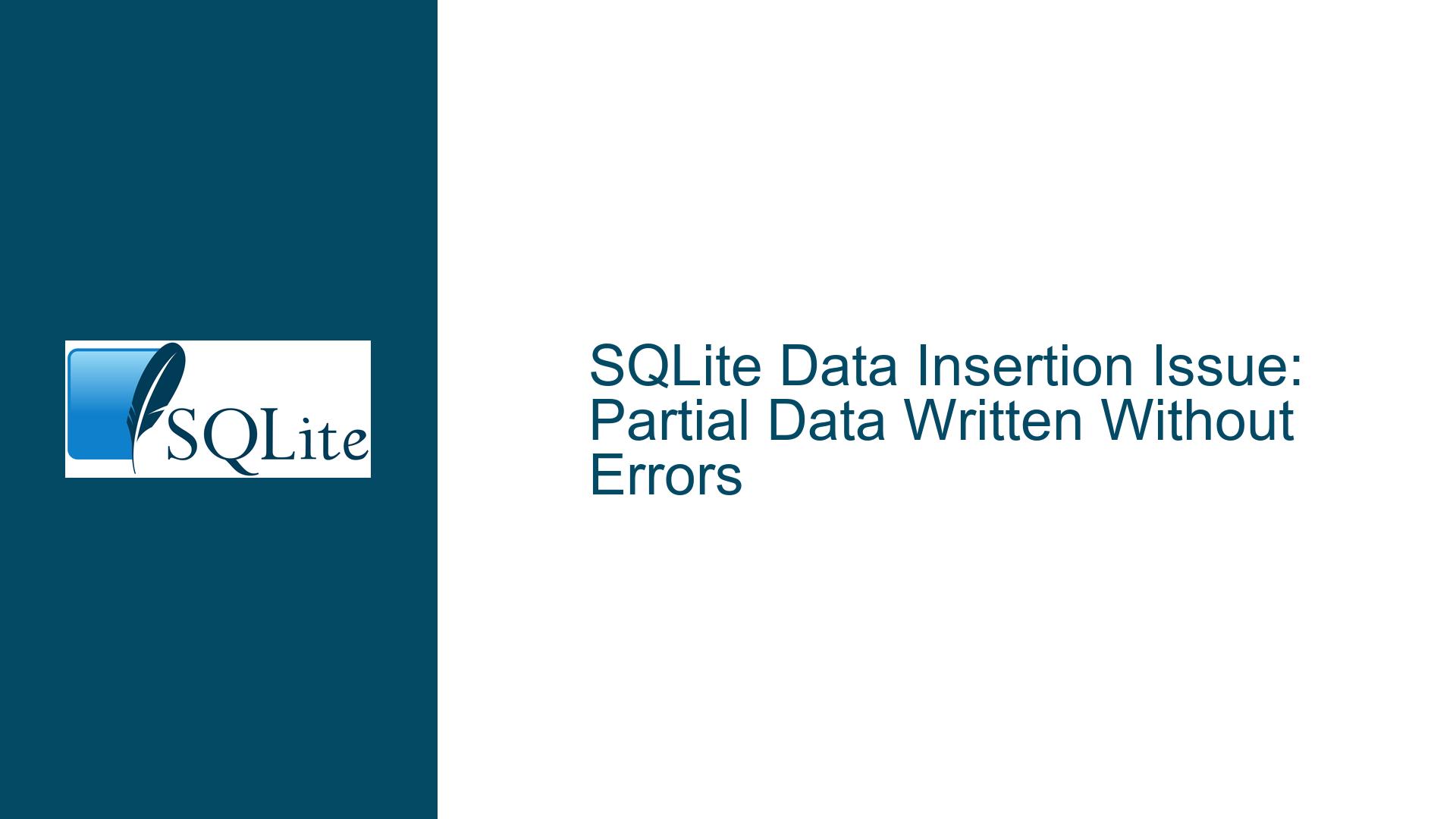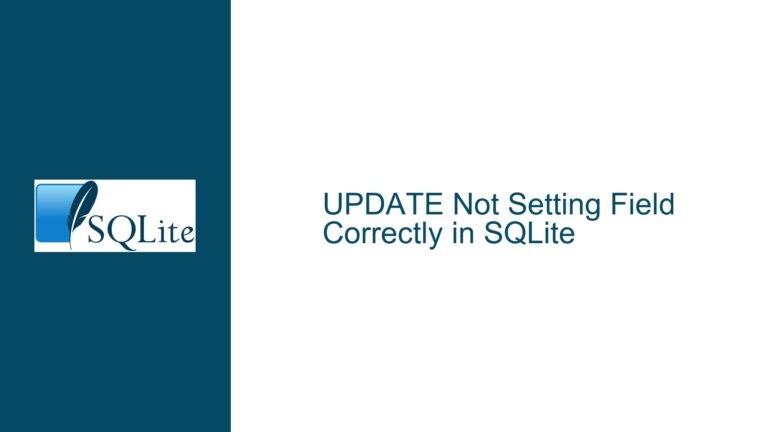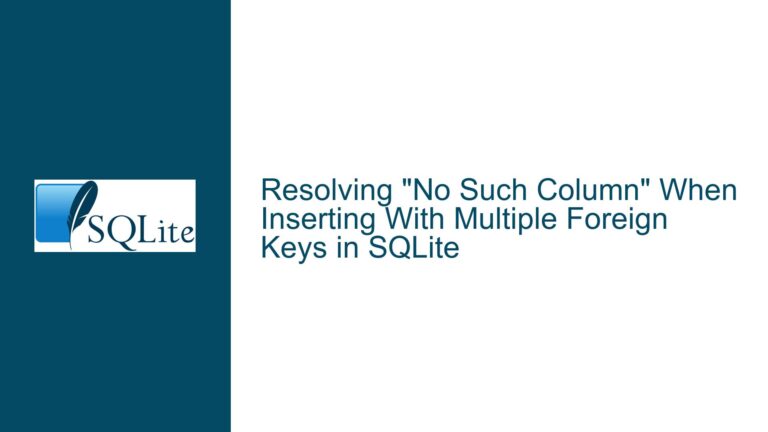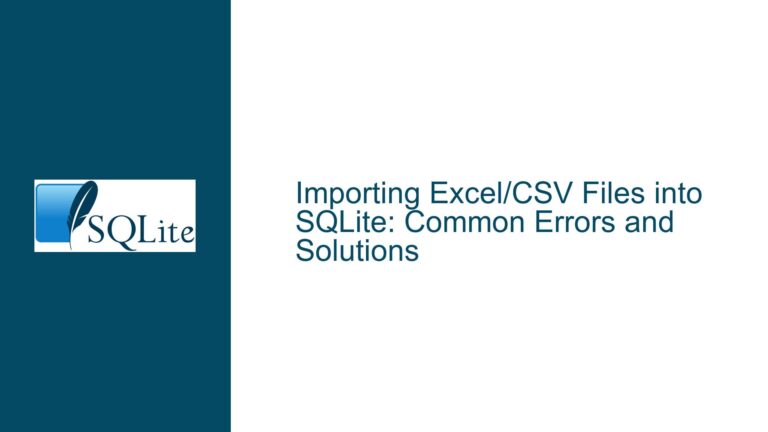SQLite Data Insertion Issue: Partial Data Written Without Errors
Schema and Insertion Logic Overview
The core issue revolves around the insertion of data into an SQLite database where the application reports successful insertions, but only a portion of the data is actually written to the database. The schema in question involves two tables: Blasting_Record_Head and Blasting_Record_Detail. The Blasting_Record_Detail table has a foreign key relationship with the Blasting_Record_Head table, specifically referencing the id column. The insertion logic is implemented using Qt’s database interface, where a prepared statement is used to insert multiple rows into the Blasting_Record_Detail table.
The Blasting_Record_Detail table is defined as follows:
CREATE TABLE Blasting_Record_Detail (
Head_id INTEGER REFERENCES Blasting_Record_Head (id) ON DELETE NO ACTION ON UPDATE NO ACTION MATCH NONE,
BurstTime INTEGER,
uID CHAR,
Delay INTEGER,
Hole INTEGER
);
The insertion logic is encapsulated in a function Insert_Blasting_Record_Replace, which iterates over a list of messages (LGMessage_List). For each message, it prepares an SQL INSERT statement, binds the necessary values, and executes the query. The function returns 0 if all insertions are successful and 1 if any insertion fails.
Possible Causes of Partial Data Insertion
The issue of partial data insertion without errors can be attributed to several potential causes, each of which needs to be carefully examined:
Transaction Management: SQLite operates in autocommit mode by default, meaning each
INSERTstatement is treated as a separate transaction. If the application does not explicitly manage transactions, partial data insertion can occur if the application crashes or is interrupted before allINSERTstatements are executed. In this case, the data inserted before the interruption would be committed, while the remaining data would be lost.Foreign Key Constraints: The
Blasting_Record_Detailtable has a foreign key constraint referencing theBlasting_Record_Headtable. If the referencedidin theBlasting_Record_Headtable does not exist, the insertion intoBlasting_Record_Detailwould fail silently if the application does not check for foreign key constraint violations. This could result in partial data insertion if someidvalues are valid while others are not.Data Type Mismatches: The
uIDcolumn in theBlasting_Record_Detailtable is defined asCHAR. If the data being inserted into this column does not match the expected data type or length, SQLite may silently truncate or reject the data without raising an error. This could lead to partial data insertion if some rows contain validuIDvalues while others do not.Concurrency Issues: If multiple threads or processes are accessing the database simultaneously, concurrency issues could arise. For example, if one process is inserting data while another process is modifying or deleting related data in the
Blasting_Record_Headtable, this could lead to inconsistent data insertion. SQLite’s locking mechanism may prevent some insertions from occurring, but this would typically result in an error rather than silent failure.Application Logic Errors: The application logic may contain errors that prevent all insertions from being executed. For example, if the
LGMessage_Listcontains fewer items than expected, or if theLG_ScanNumbervariable is not correctly set, the function may return prematurely, resulting in partial data insertion.Database Corruption: Although rare, database corruption could cause data to be partially written without raising an error. This could occur due to hardware issues, file system errors, or bugs in the SQLite library. In such cases, the database may need to be repaired or restored from a backup.
Troubleshooting Steps, Solutions & Fixes
To diagnose and resolve the issue of partial data insertion, the following troubleshooting steps and solutions should be implemented:
Explicit Transaction Management: Ensure that the application explicitly manages transactions when performing multiple insertions. This can be done by wrapping the insertion logic in a transaction block using
BEGIN TRANSACTIONandCOMMITstatements. If any insertion fails, the entire transaction can be rolled back usingROLLBACK, ensuring that either all insertions are committed or none are.query->exec("BEGIN TRANSACTION"); for (int i = 0; i < count; i++) { // Prepare and execute the INSERT statement if (!query->exec()) { query->exec("ROLLBACK"); return 1; // fail } } query->exec("COMMIT");Foreign Key Constraint Validation: Before inserting data into the
Blasting_Record_Detailtable, validate that the referencedidvalues exist in theBlasting_Record_Headtable. This can be done by executing aSELECTquery to check for the existence of eachidbefore performing the insertion.QSqlQuery checkQuery; checkQuery.prepare("SELECT id FROM Blasting_Record_Head WHERE id = :Head_id"); checkQuery.bindValue(":Head_id", id); if (!checkQuery.exec() || !checkQuery.next()) { // The referenced id does not exist return 1; // fail }Data Type Validation: Ensure that the data being inserted into the
uIDcolumn matches the expected data type and length. This can be done by validating theuIDstring before binding it to the query. If theuIDstring is too long or contains invalid characters, it should be rejected or truncated to the appropriate length.QString Str = QString("") .sprintf("%02x%02x%02x%02x%02x%02x%02x", _lgmagd_temp.Uid[0], _lgmagd_temp.Uid[1], _lgmagd_temp.Uid[2], _lgmagd_temp.Uid[3], _lgmagd_temp.Uid[4], _lgmagd_temp.Uid[5], _lgmagd_temp.Uid[6]); if (Str.length() > MAX_UID_LENGTH) { // The uID string is too long return 1; // fail }Concurrency Control: If the application is multi-threaded or accessed by multiple processes, implement concurrency control mechanisms to prevent data inconsistencies. This can be done using SQLite’s
BEGIN EXCLUSIVE TRANSACTIONstatement to lock the database during critical sections of code.query->exec("BEGIN EXCLUSIVE TRANSACTION"); for (int i = 0; i < count; i++) { // Prepare and execute the INSERT statement if (!query->exec()) { query->exec("ROLLBACK"); return 1; // fail } } query->exec("COMMIT");Application Logic Review: Review the application logic to ensure that all necessary insertions are being executed. Verify that the
LGMessage_Listcontains the expected number of items and that theLG_ScanNumbervariable is correctly set. If the function returns prematurely, adjust the logic to ensure that all insertions are attempted.Database Integrity Check: Perform a database integrity check to rule out corruption as a cause of the issue. This can be done using the
PRAGMA integrity_checkcommand, which will report any inconsistencies or corruption in the database.QSqlQuery integrityQuery; integrityQuery.exec("PRAGMA integrity_check"); while (integrityQuery.next()) { QString result = integrityQuery.value(0).toString(); if (result != "ok") { // Database corruption detected return 1; // fail } }Error Logging and Debugging: Enhance error logging to capture more detailed information about the insertion process. Log the SQL statements being executed, the values being bound, and the results of each insertion. This will help identify any patterns or specific conditions under which the issue occurs.
if (!query->exec()) { QString error = query->lastError().text(); LOG_PRT("Insertion failed: %s\n", error.toUtf8().constData()); return 1; // fail }Database Backup and Restore: As a last resort, if database corruption is suspected, restore the database from a backup. Ensure that regular backups are taken to minimize data loss in the event of corruption.
By systematically addressing each of these potential causes and implementing the corresponding solutions, the issue of partial data insertion without errors can be effectively diagnosed and resolved. This approach ensures that the database remains consistent and that all data is correctly written, even in the face of unexpected conditions or errors.






